Common Cape Invasives, How to Get Rid of Them
and Replace Them With Similar Natives
Characteristics of Non-Native Invasive Species (not all non-natives are invasive)
- Impacts the ecology and/or economy to the area it was introduced
- Outcompetes and overwhelms the native flora
- Grows and reproduces fast
- Lacks native predators to slow their growth (nothing is eating these plants!)
Why Remove Invasive Species
They outcompete native plants that native wildlife depends on for survival. These have developed specific relationships over thousands of years of coevolution. Some species are so dependent on specific plants to feed on or that they can only use a certain plant to lay eggs on, for example, monarch butterflies and milkweed. But there are many more with such specific needs.
Invasive plants spread and create monocultures, leading to loss of biodiversity. I can attest to the lack of diversity in the space we have cleared of burning bush at Little Magothy Beach. There was nothing but burning bush as far as the eye could see. Tucked amongst them were some native sassafras just waiting for their chance to thrive. We have added some native trees and shrubs in hopes of creating a much more robust ecosystem!
Often the damage caused by invasive species cause irreversible damage to the environment, reduce recreational space and affect human health. There is also a significant economic factor—the time and expense of removing invasive species from a space.
How Invasive Species Come Into An Area
Invasive species are often sold at our local nurseries. Homeowners believe them to be safe to plant or not harmful because they are so commonly seen on landscapes and sold to us by landscapers and the nursery trade. We plant them on our landscapes and they spread through seed dispersal, wind, and root systems, and not just in our own property but out into common areas or to the wild.
They can come from many unintentional means by humans as well through travel and trade or the soles of our shoes after walking through an infested area.
How You Can Help Stop Invasive Plants
Don’t buy non-native invasive plants Just because you don’t see it spreading it in your landscape doesn’t mean it hasnt spread to other areas. The seeds and roots can travel great distances and create havoc somewhere out there. That non-native invasive, sacred bamboo, the nursery tells you is a variety, it will eventually revert to producing seed. The invasive Bradford pear that we were told was sterile is now along every corridor on the east coast. Create demand for native plants by asking your local big-box stores to carry more natives. Shop at local native plant nurseries and pop-up sales (such as the Cape Conservation Corps plant sales)
Common Cape Invasives
There are many invasive plant species in the yards and open spaces of the Cape. The small trees, shrubs, vines, herbaceous, and grass plants listed below are among the most common and are the worst of the worst invasives as they are known to spread aggressively by seed or roots. They are also more easily removed by homeowners compared with invasives such as grown trees, bamboo, and phragmites reeds.
Small Trees and Shrubs
Bradford or Callery Pear |
| Removal |
| Pull or dig up seedlings and small trees. Cut larger trees and stump sprouts |
| Native alternatives |
| Redbud, sweet bay magnolia, serviceberry, arrowwood viburnum, fringe- tree |
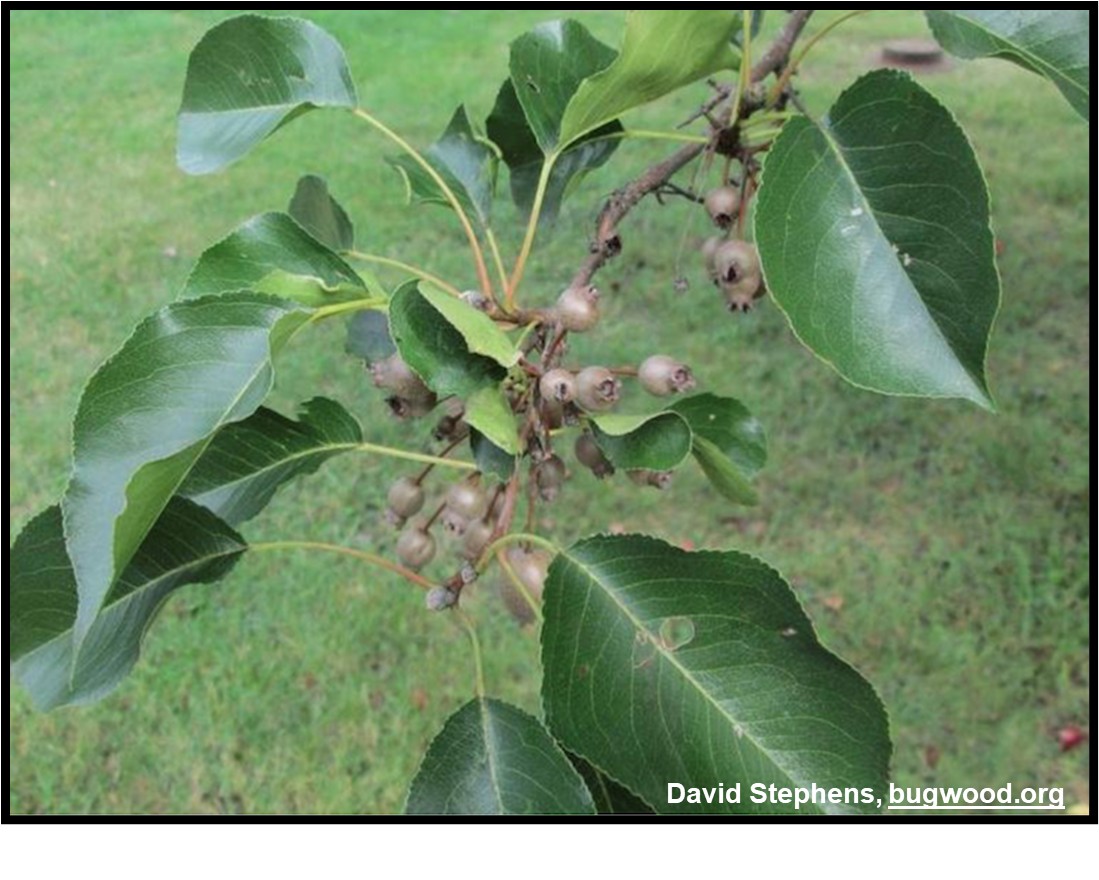
Burning Bush |
| Removal |
| Pull or dig up seedlings and small bushes. Cut large bushes to the ground. |
| Native alternatives |
| Red chokeberry, Virginia sweet spire, high- bush blueberry, maple leaf viburnum |
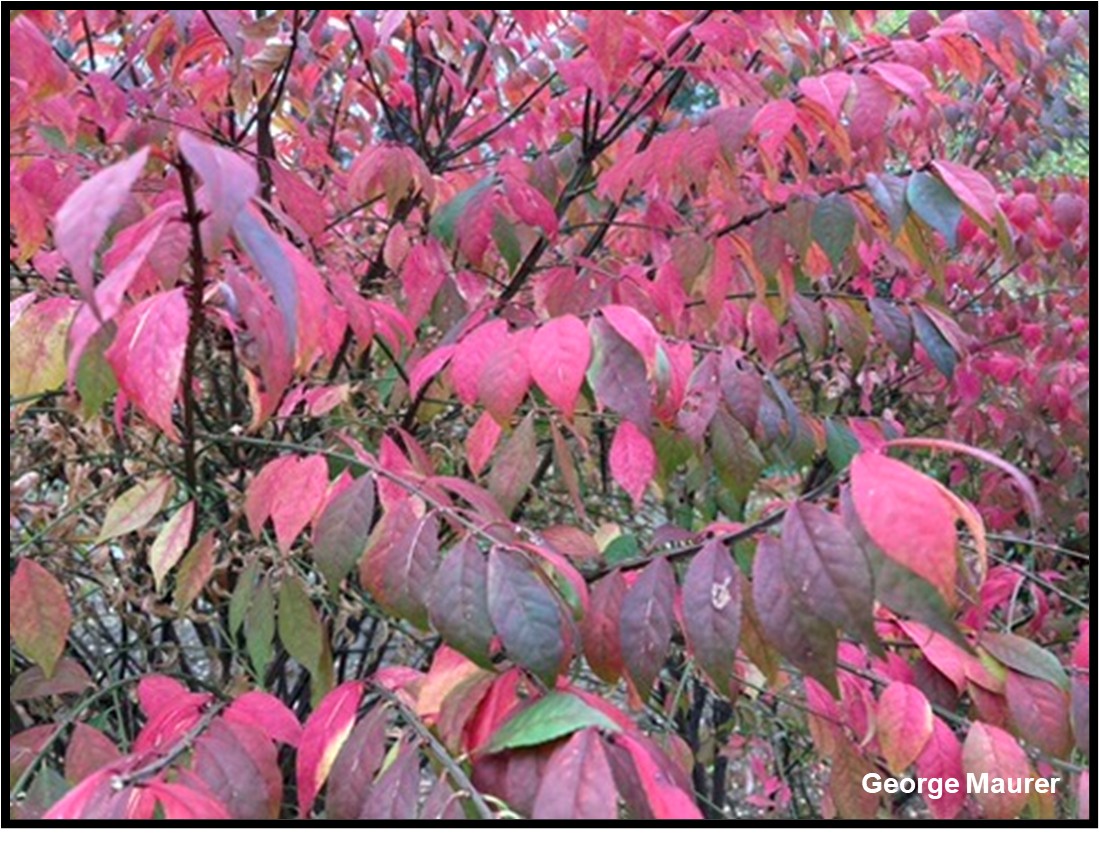
Butterfly Bush (purple and white) |
| Removal |
| Pull or dig up seedlings and small bushes. Cut large bushes to and stump sprouts. |
| Native alternatives |
| New York ironweed, Virginia sweet spire, sweet pepper bush, joe pye weed. |
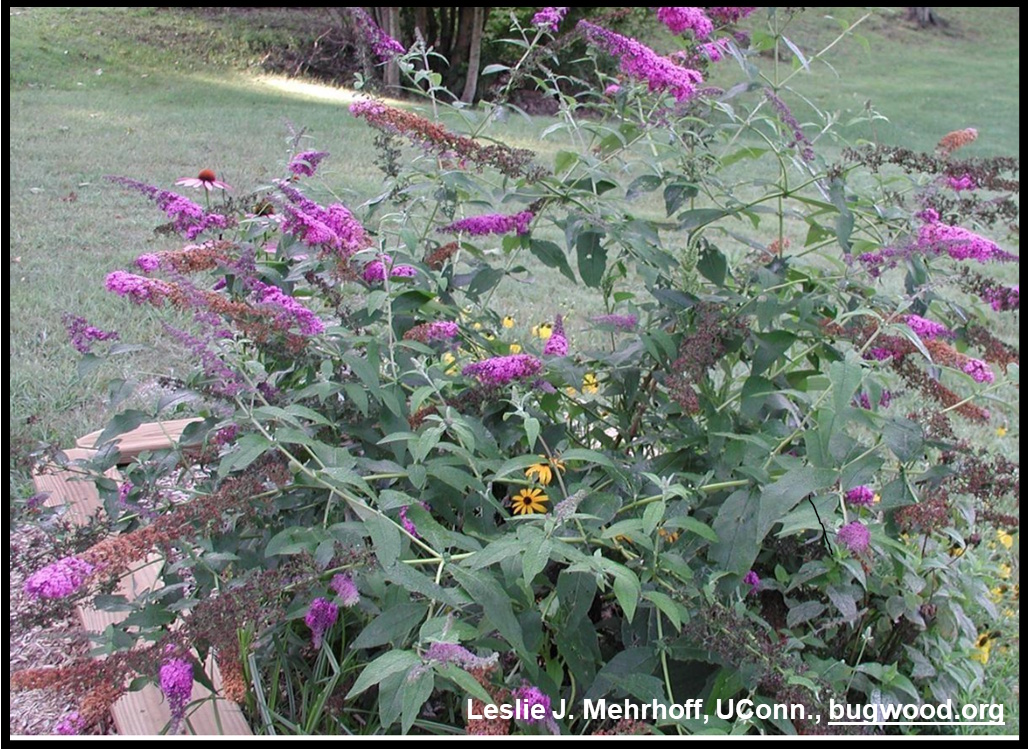
Japanese Barberry |
| Removal |
| Pull or dig Cut larger trees and stump sprouts |
| Native alternatives |
| northern bayberry, sweet pepper bush, highbush blueberry |

Mimosa |
| Removal |
| Pull or dig up seedlings and small trees. Cut or girdle large trees, and cut stump |
| Native alternatives |
| Flowering dogwood, service berry, sweet bay magnolia, redbud. |
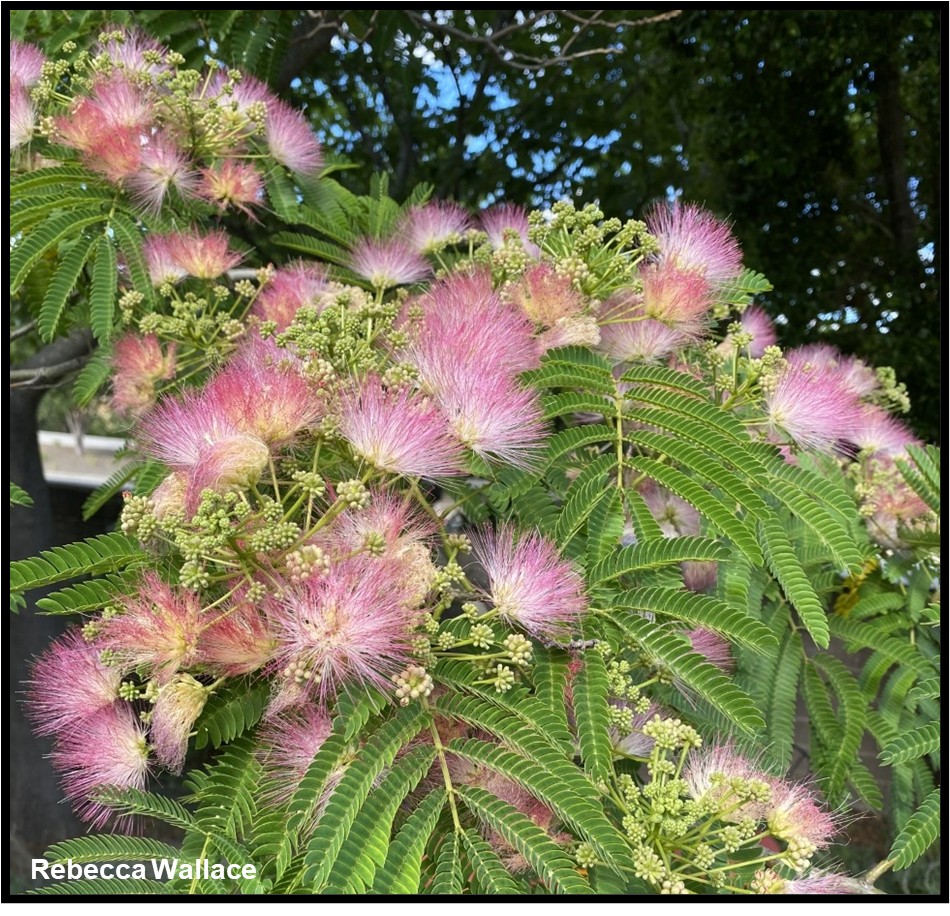
Privet |
| Removal |
| Pull or dig up seedlings and small plants. Cut large plants. |
| Native alternatives |
| Inkberry, black chokeberry, spicebush. |
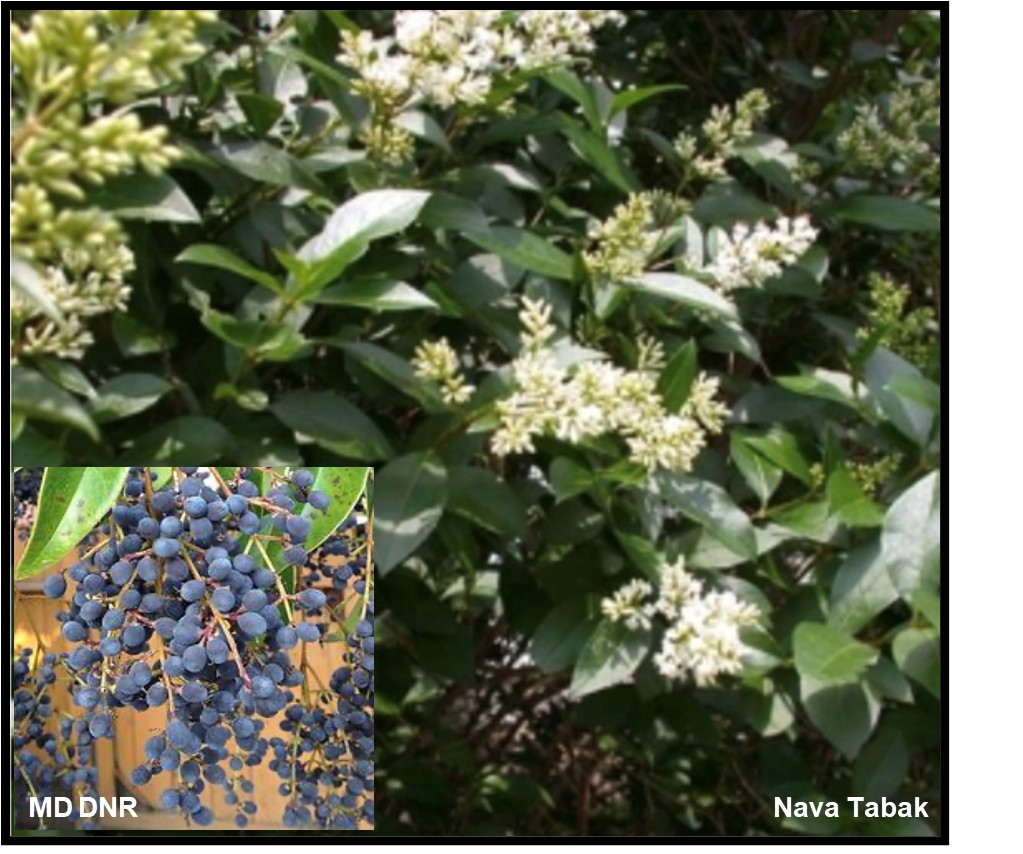
Rose of Sharon |
| Removal |
| Pull or dig up seedlings and small plants. Cut large plants. |
| Native alternatives |
| Rose mallow, sweet bay magnolia, flowering dogwood. |

Sacred Bamboo |
| NOTE: The berries are poisonous to pets and wildlife. They will kill birds that eat them, such as robins, cedar waxwings, bluebirds, and mockingbirds. |
| Removal |
| Pull or dig up including the roots. |
| Native alternatives |
| Winterberry, red chokeberry, inkberry. |
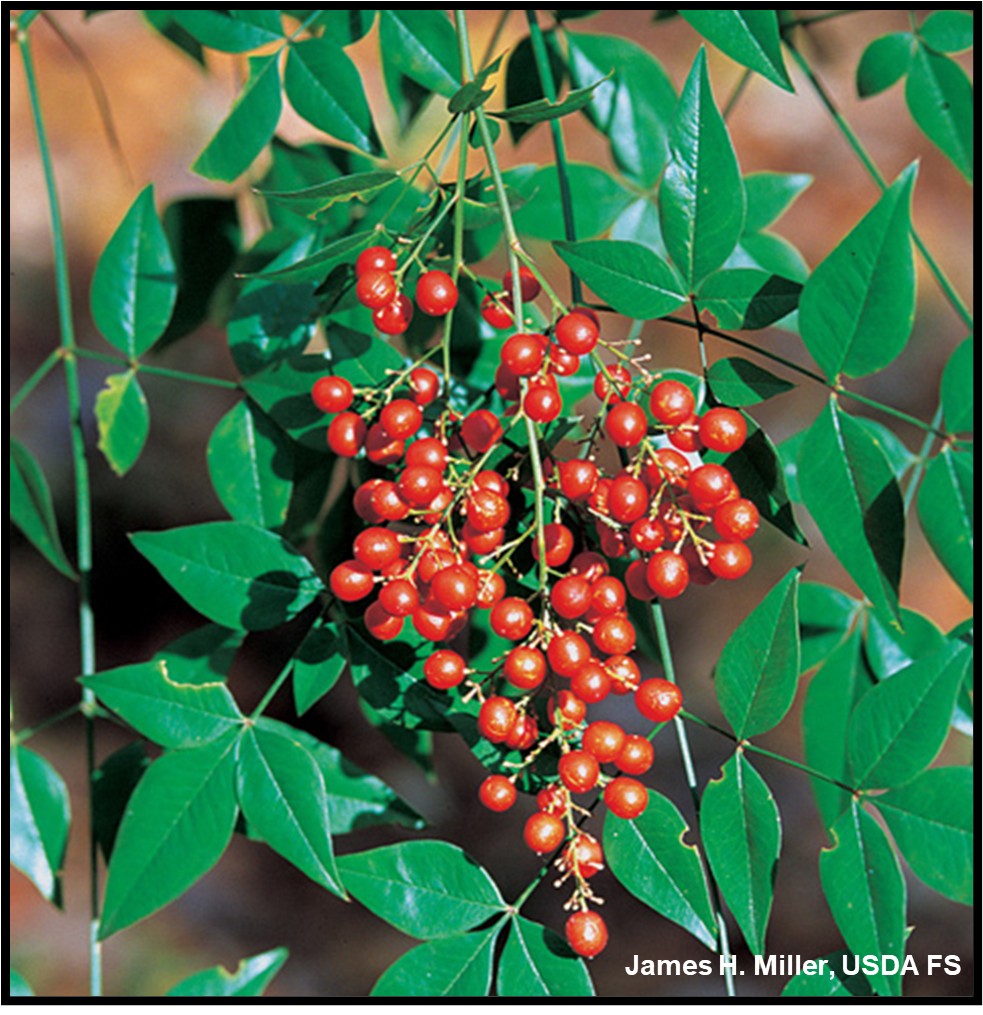
Wineberry |
| Removal |
| Pull, or dig up. |
| Native alternatives |
| Blackberry, black raspberry, red chokeberry, flowering raspberry |

Herbaceous Plants and Grasses
Asiatic Day Flower |
| Removal |
| Pull, dig up, or smother with a thick layer of leaves or other mulch. |
| Native alternatives |
| Native day flower species, spiderwort. |

Black Fountain Grass |
| Removal |
| Pull, dig up, weed whack, or mow. Repeat as necessary. |
| Native alternatives |
| Bottlebrush grass, pink muhly grass, blue fescue, Foerster’s feather reed grass, little blue stem, prairie drop seed. |

Chinese Silver Grass |
| Removal |
| Pull or dig up, including the roots to prevent re-sprouting. |
| Native alternatives |
| Big bluestem, bushy beardgrass, bottlebrush grass, switchgrass, indiangrass. |

Day Lily |
| Removal |
| Pull or dig up, including the roots to prevent re-sprouting. |
| Native alternatives |
| Ox-eye sunflower, Canada Lily, wood lily, Turk’s cap lily, three-lobed coneflower. |
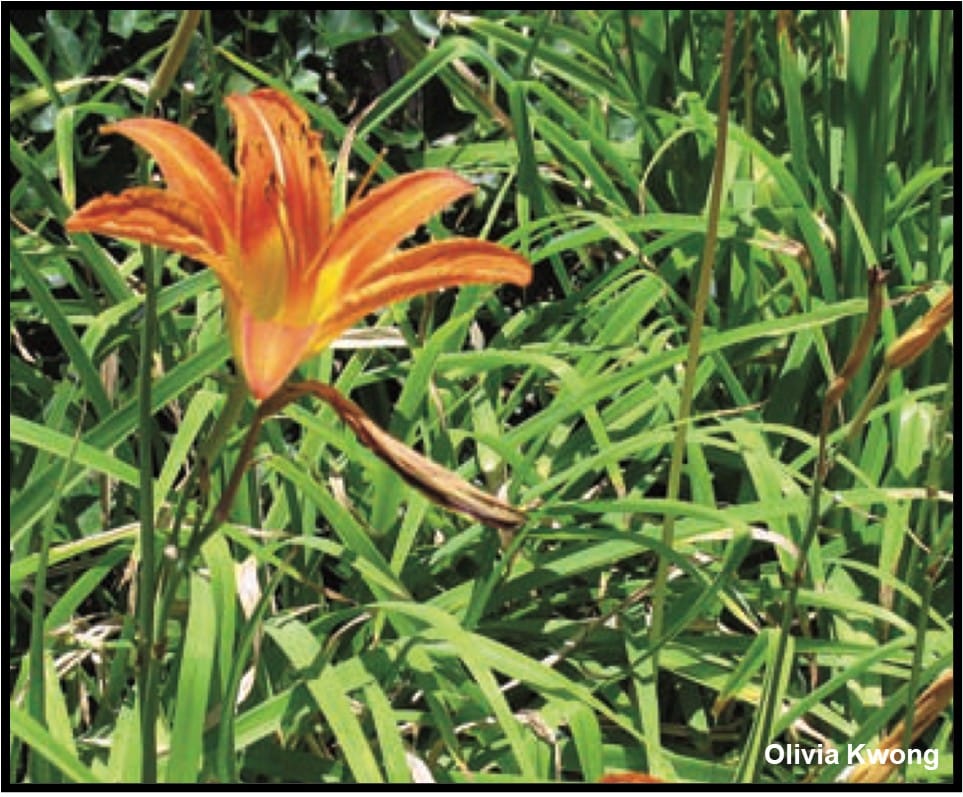
Garlic Mustard |
| Removal |
| Pull or dig up, including the roots to prevent re-sprouting. May require repeated removal for some time. |
| Native alternatives |
| Wild ginger, foam flower, creeping phlox, lady fern, evergreen wood fern, New York fern. |
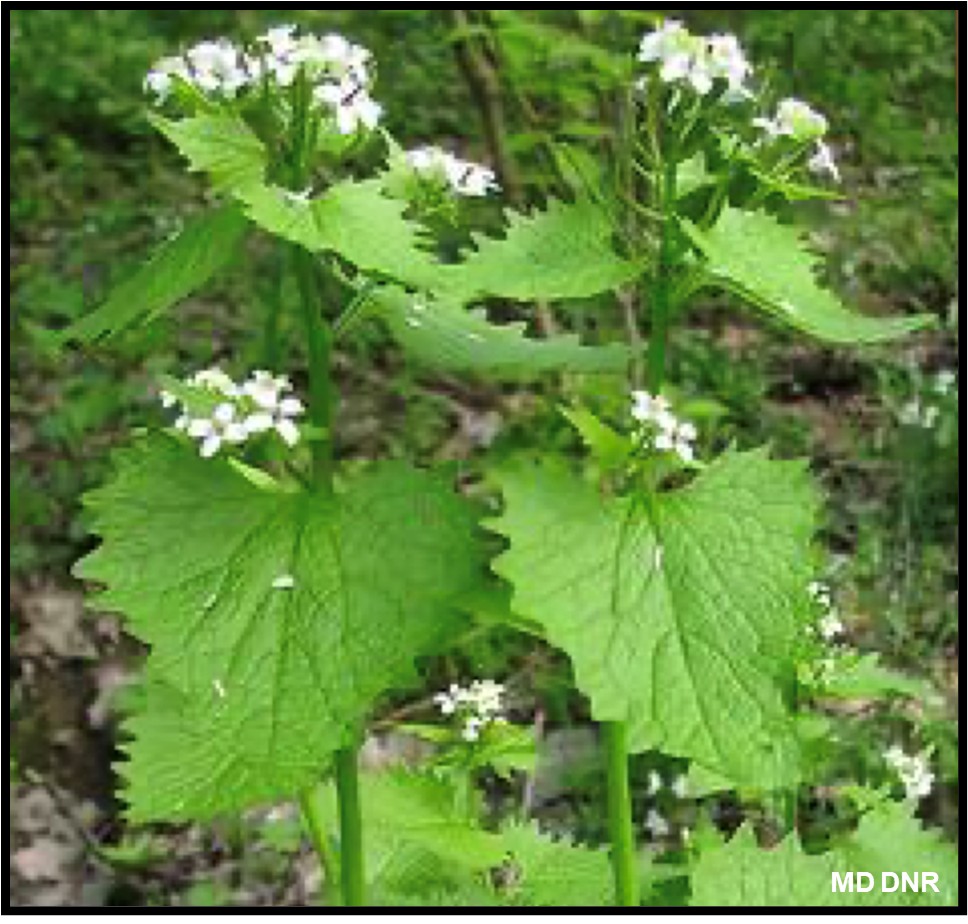
Vines
English Ivy |
| Removal |
| Pull, dig up, smother with a thick layer of leaves or other mulch, or cut with mower or weed wacker. Cut vines growing up trees at the ground and repeat until the roots die. |
| Native alternatives |
| Virginia creeper, trumpet vine, and as a ground cover: wild ginger, foam flower, creeping phlox, green & gold, lady fern, evergreen wood fern, New York fern. |

Japanese Honeysuckle |
| Removal |
| Pull, dig up, or cut with mower or weed wacker. Cut vines growing up trees at ground level and repeat until the roots die. |
| Native alternatives |
| Virginia creeper, trumpet vine, cross vine, trumpet or coral honeysuckle, pipe vine, passion flower. |
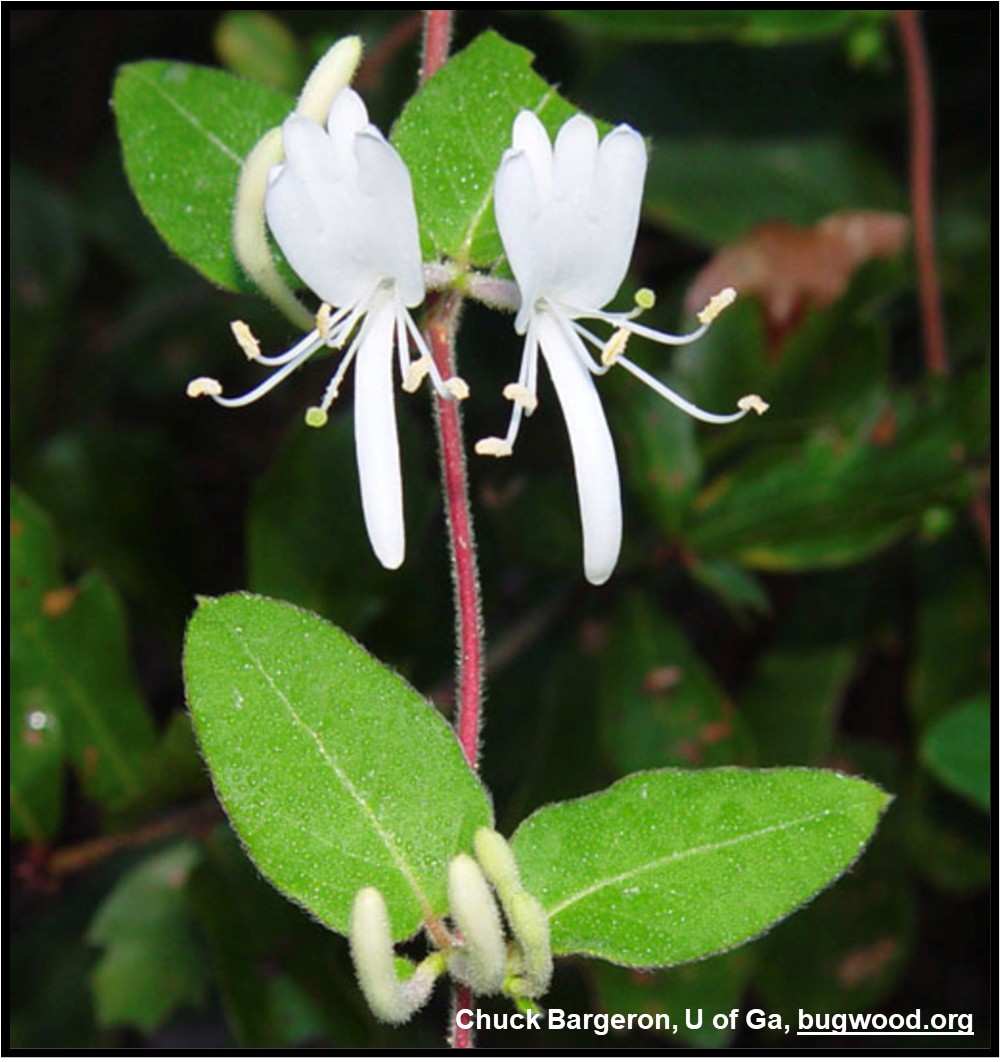
Oriental Bittersweet |
| Removal |
| Pull, dig up, or cut with mower or weed wacker. Cut vines growing up trees at ground level and repeat until the roots die. |
| Native alternatives |
| Virginia creeper, trumpet vine, cross vine, trumpet or coral honeysuckle, pipe vine, passion flower. |
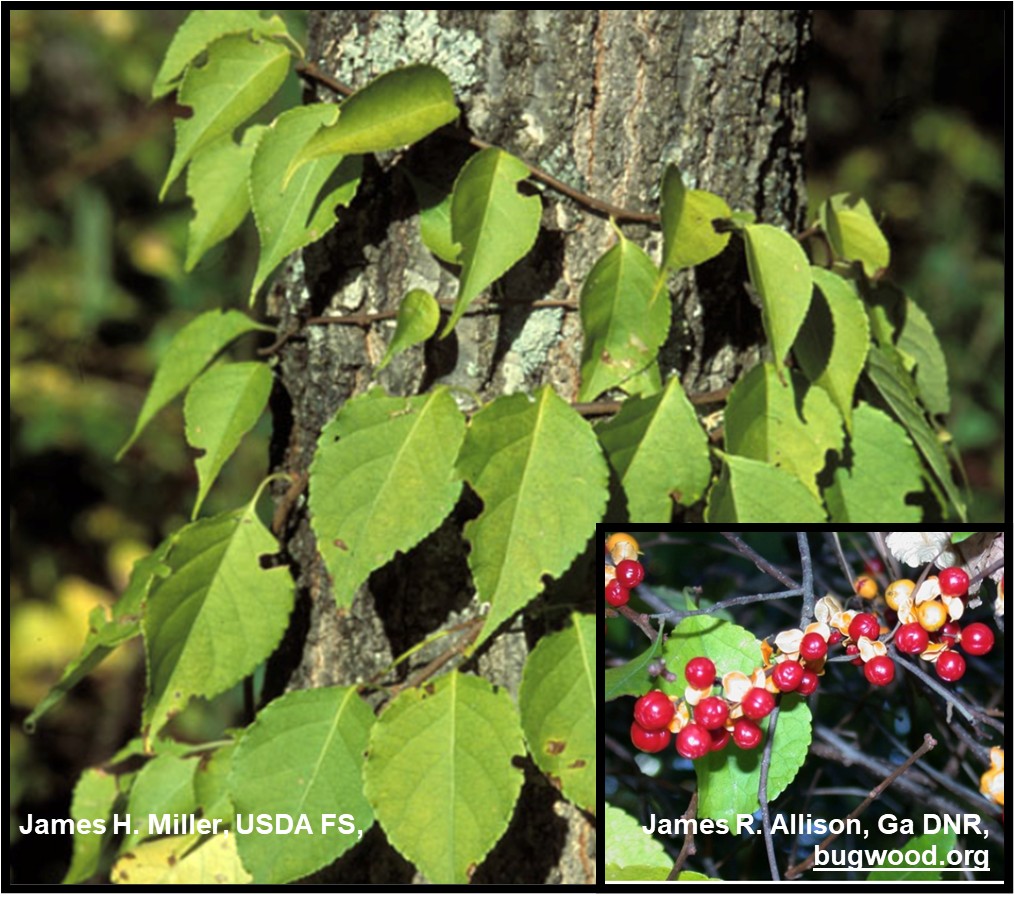
Periwinkle |
| Removal |
| Pull, dig up, smother with a thick layer of leaves or other mulch, or cut with mower or weed wacker. Repeat until the roots die. |
| Native alternatives |
| Wild ginger, foam flower, creeping phlox, green & gold, lady fern, evergreen wood fern, New York fern. |
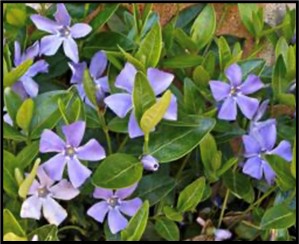
Porcelainberry |
| Removal |
| Pull, dig up, or cut with mower or weed whacker. Cut at the ground for vines climbing trees. Repeat until the roots die. |
| Native alternatives |
| Virginia creeper, trumpet vine, cross vine, trumpet or coral honeysuckle, pipe vine, passion flower. |
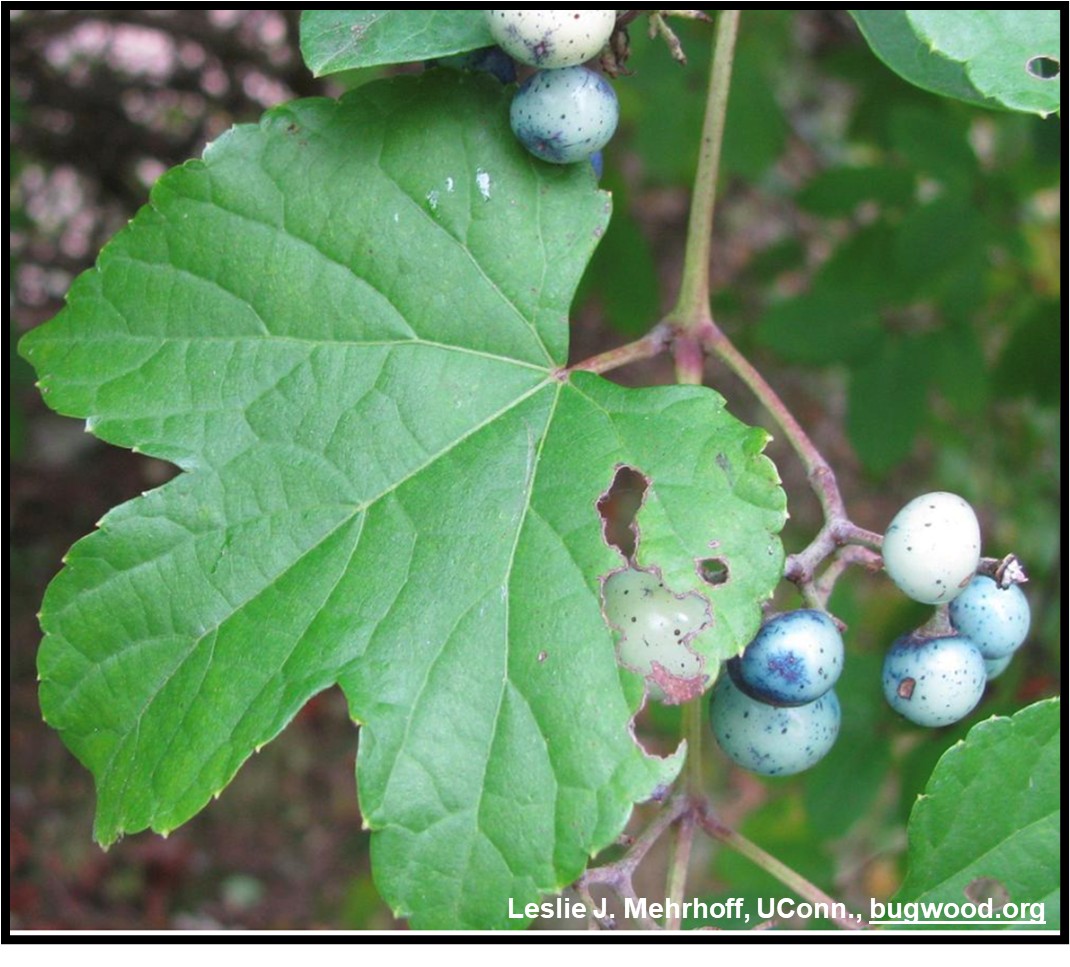
Sweet Autumn Virgin's Bower or Japanese Clematis |
| Removal |
| Pull, dig up, or cut with mower or weed whacker. Cut at the ground for vines climbing trees. Repeat until the roots die. |
| Native alternatives |
| Virginia creeper, trumpet vine, cross vine, trumpet or coral honeysuckle, pipe vine, passion flower. |
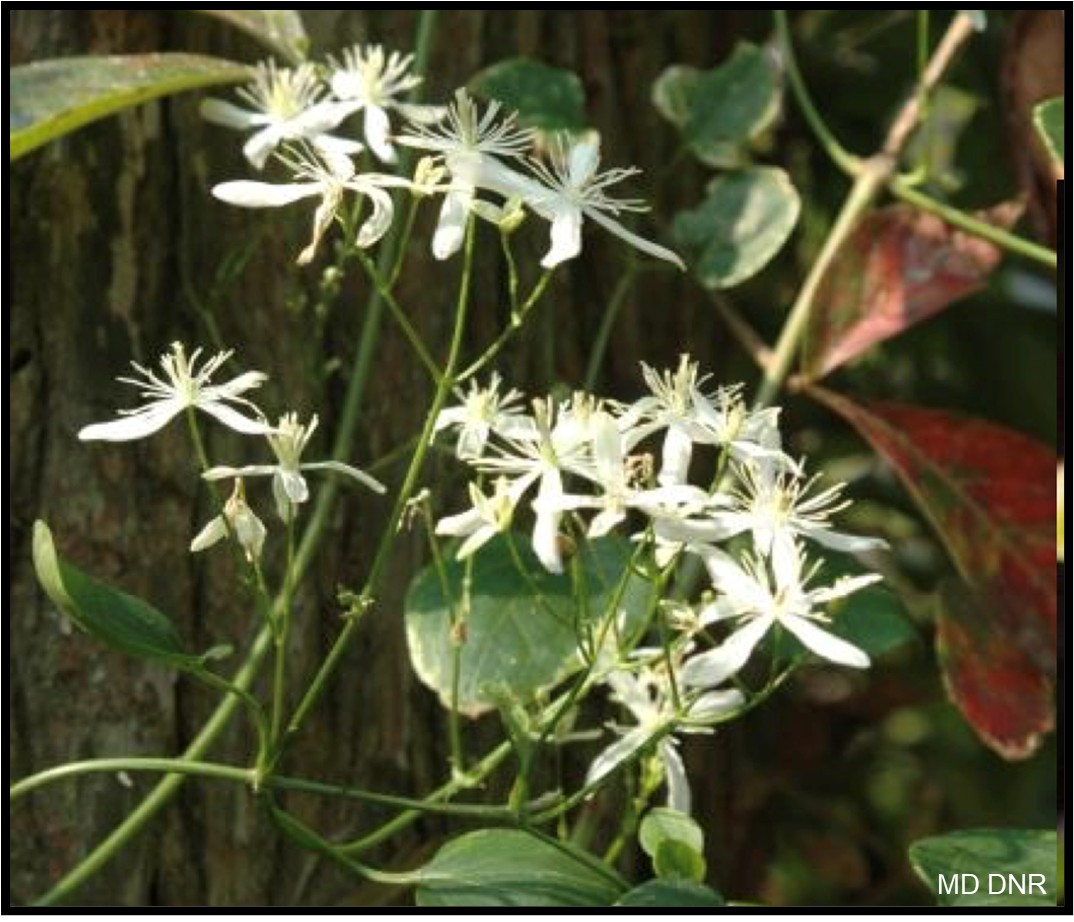
SOURCES
National Park Service, U.S. Forest Service, Plant Invaders of Mid-Atlantic Natural Areas.
MD Department of Natural Resources
Common Invasive Plants Easy ID Cards
University of Maryland Extension, Website, and the Maryland Master Gardener Handbook
Invasive.org
Maryland Invasive Species Council
Various Google Searches

